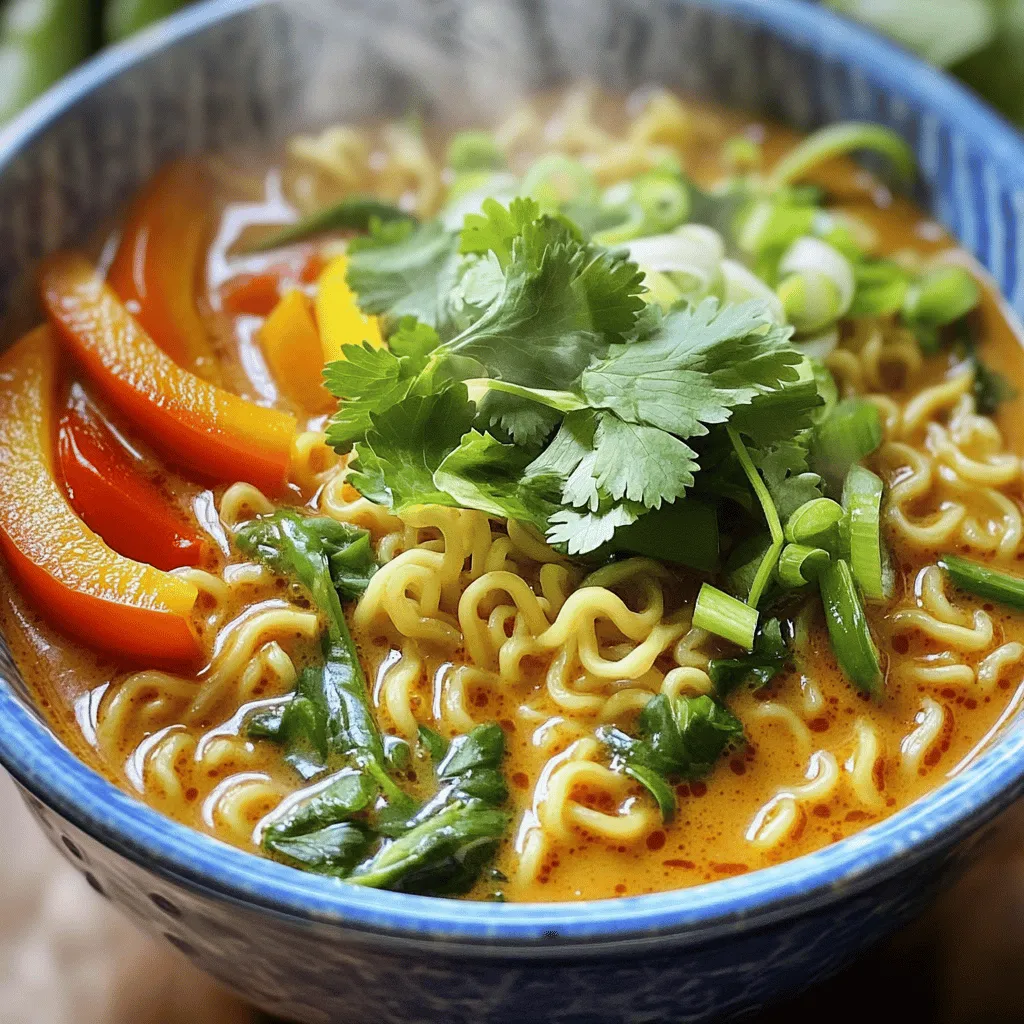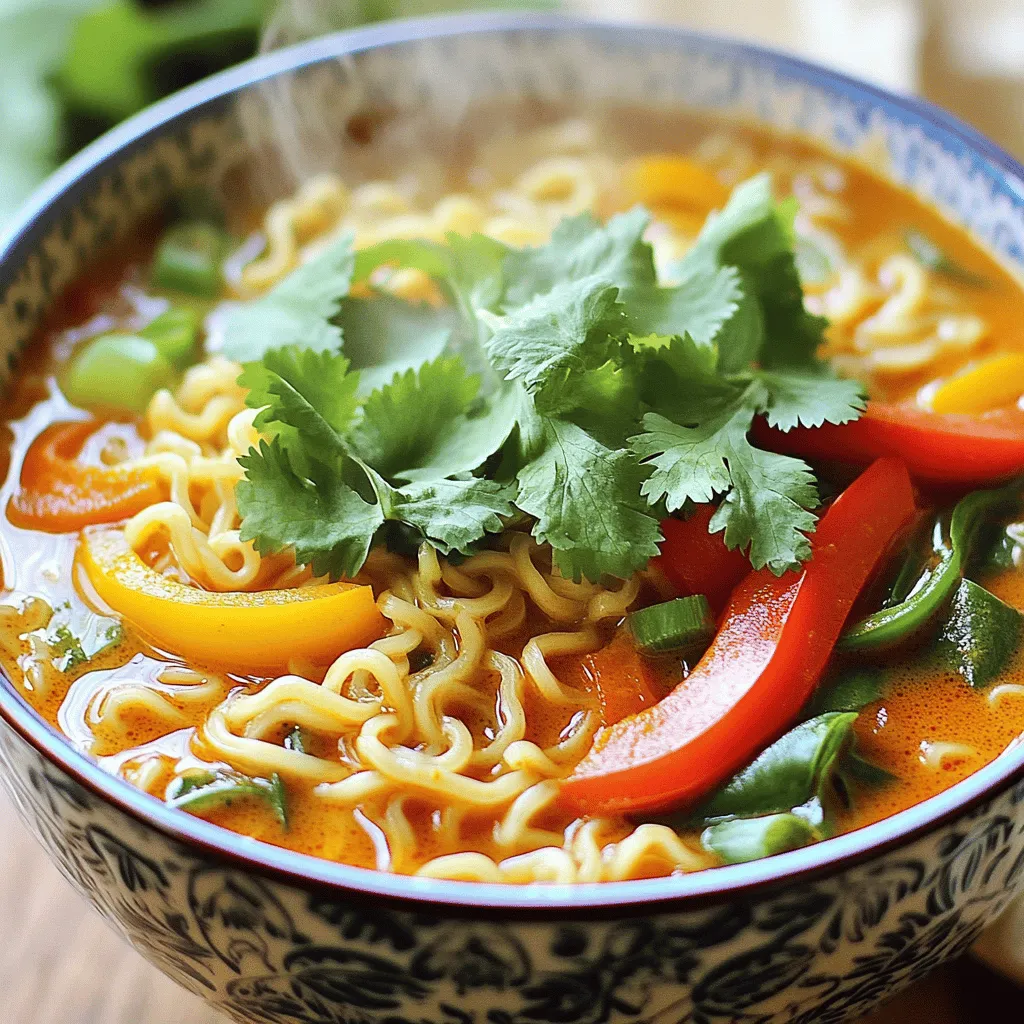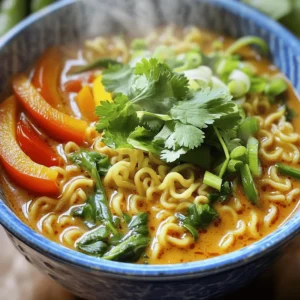If you’re craving a bowl of warm comfort, look no further! Coconut Curry Ramen offers the perfect balance of creamy coconut, rich spices, and tender noodles. In this delightful and easy recipe, you’ll discover how to create a dish so flavorful, you’ll never want to stop slurping. Whether you’re a cooking novice or a seasoned pro, I’ll guide you step by step. Let’s dive into this tasty adventure together!

Ingredients
List of Ingredients
– 2 servings ramen noodles
– 1 can (13.5 oz) coconut milk
– 1 tablespoon red curry paste
– 2 cups vegetable broth
– 1 medium onion, thinly sliced
– 2 cloves garlic, minced
– 1 tablespoon ginger, freshly grated
– 1 cup bell peppers, sliced (your choice of color)
– 1 cup leafy greens (such as spinach or bok choy)
– 1 tablespoon soy sauce
– 1 tablespoon fresh lime juice
– Fresh cilantro, chopped, for garnish
– Salt and pepper, to taste
– Optional: Sliced green onions and sesame seeds for an extra sprinkle
Recommended Brands for Curry Paste and Coconut Milk
For the best taste, I recommend using Thai Kitchen Red Curry Paste. It has a great balance of spice and flavor. For coconut milk, Aroy-D is a fantastic choice. It’s thick and creamy, enhancing your ramen.
Ingredient Substitutions
If you don’t have red curry paste, try yellow curry paste for a milder taste. You can swap coconut milk with almond milk, but the flavor will change. Use any broth you prefer, such as chicken or mushroom broth, if you want a different base. For leafy greens, you can use kale or collard greens in place of spinach or bok choy.
Step-by-Step Instructions
Preparation of Aromatics
Start by heating a tablespoon of oil in a large pot over medium heat. Once the oil is hot, add the sliced onion. Cook the onion for about 5 minutes, stirring often. You want it to turn soft and translucent. Next, add the minced garlic and grated ginger to the pot. Cook this mixture for an extra 1-2 minutes until it smells great.
How to Infuse Flavors and Add Curry
Now it’s time to add some flavor! Stir in the tablespoon of red curry paste. Mix it well with the onions, garlic, and ginger. Let it cook for one minute. This helps the curry paste release its rich flavors. After that, pour in the vegetable broth and the coconut milk. Stir everything together and turn up the heat a little. Bring the mixture to a gentle simmer.
Cooking the Ramen Noodles
While the broth simmers, cook the ramen noodles in another pot. Follow the package instructions for the best result. Once the noodles are done, drain them and set them aside. When the broth is ready, add the sliced bell peppers. Cook for about 5 minutes until they soften but still have a little crunch. Toss in your leafy greens and stir until they just wilt, which takes about 2 minutes. Finally, stir in soy sauce and lime juice. Taste the broth and add salt and pepper as needed.
To serve, divide the cooked ramen noodles into bowls. Ladle the tasty coconut curry broth and veggies over the noodles. Don’t forget to garnish with fresh cilantro for a pop of color and flavor!
Tips & Tricks
Cooking Techniques for Perfect Ramen
To ensure your ramen noodles turn out great, follow these steps:
– Cook the noodles in boiling water until just tender.
– Drain them and rinse under cold water. This stops cooking.
– Add the noodles to your bowl right before serving. This keeps them from getting soggy.
How to Adjust Spiciness and Flavor
You can make your ramen just how you like it!
– Add more red curry paste for heat. Start with a little and taste.
– For a milder dish, use less curry paste.
– If you want a tangy kick, squeeze in more lime juice.
Presentation Tips for Serving
Serving your dish well makes it more fun to eat!
– Use deep bowls to show off the colors of the veggies.
– Add a lime wedge on the side for extra flavor.
– Top with fresh cilantro and green onions for a pop of color.
– A sprinkle of sesame seeds adds a nice touch!

Variations
Vegan and Vegetarian Options
You can easily make this dish vegan or vegetarian. Use vegetable broth and coconut milk as your base. Instead of meat, load up on veggies. Try mushrooms, zucchini, or carrots. They add great flavor and texture. You can also add tofu for protein. Firm tofu works best; just drain and cube it. Sauté the tofu with the aromatics for extra taste.
Protein Additions (e.g., tofu, chicken, shrimp)
Want to add protein? Consider chicken or shrimp. For chicken, use bite-sized pieces. Cook them after the aromatics until golden brown. Add them back in with the broth. For shrimp, add them when the broth simmers. They only need a few minutes to cook. Tofu is also a great option. It soaks up the flavors and adds nice texture.
Different Vegetable Combinations
Feel free to mix up the vegetables! Broccoli, snap peas, or carrots make great choices. You can also use frozen veggies if fresh ones aren’t available. Just add them during the simmering step. This keeps them bright and tasty. Remember, the more colorful your bowl, the more inviting it looks. Get creative and enjoy making it your own!
Storage Info
How to Store Leftovers
To keep your coconut curry ramen fresh, store leftovers in an airtight container. Make sure to let the ramen cool down before sealing it. Place the container in the fridge. It will stay good for about three days. If you have extra broth, store it separately. This helps keep the noodles from getting too soggy.
Reheating Instructions
When you’re ready to enjoy the leftovers, you can heat them up easily. Pour the ramen into a pot over medium heat. If you stored the broth separately, add it in as well. Stir well and heat until it’s warm. You can also use the microwave. Place the ramen in a microwave-safe bowl, cover it, and heat in short bursts. Stir in between to ensure even heating.
Freezing and Thawing Guidelines
If you want to save your coconut curry ramen for later, freezing is a great option. First, let the ramen cool completely. Then, pour it into a freezer-safe container. You can also freeze the broth and noodles separately. When you want to eat it, move it to the fridge overnight to thaw. Once thawed, reheat as mentioned above. Enjoy your tasty meal on a busy day!
FAQs
What is the best type of ramen noodles for this recipe?
I recommend using fresh or dried ramen noodles. They have a great texture and flavor. Fresh noodles cook quickly and add a nice bite. Dried noodles are easy to find and work well, too. Just follow the package instructions for cooking time.
Can I use other types of curry paste?
Yes, you can! Red curry paste is my favorite for its rich flavor. However, you can use green or yellow curry paste. Each type has a unique taste. Adjust the amount depending on how spicy you want your soup. Taste as you go to find your perfect balance.
How can I make Coconut Curry Ramen gluten-free?
To make this dish gluten-free, use gluten-free ramen noodles. They are easy to find in stores. Also, make sure to use tamari instead of soy sauce. Tamari has a similar taste but is gluten-free. Check labels for any hidden gluten in your ingredients.
This blog post covered key ingredients, step-by-step instructions, and useful tips for making Coconut Curry Ramen. You learned about ingredient choices, cooking techniques, and variations for different diets. I hope you feel ready to create a delicious bowl of ramen. Remember, cooking is about experimenting and having fun. Enjoy your culinary journey and share your tasty results!

